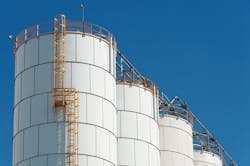Q: A tank at the outlet of a process upstream is used as the feed tank for a downstream process. The flow into the tank depends on the operation of the upstream process while its outlet flow is set by the operator. The tank typically overflows about once a month and the pump has run dry on occasion. What control strategies should be considered to better control the tank level and avoid these undesirable operating conditions?
A. Manual
B. Feedback
C. Cascade
D. Feedforward
E. Advanced
Let’s investigate the existing operation before considering modifications. The information given suggests that the inlet flow is not controlled per se but that it is affected by the upstream process and hence, reflective of the stability of the upstream process. It appears that the operator periodically adjusts the outlet flow (to the downstream process) to keep the tank level within reasonable limits. Overflowing the tank and running the pump dry likely occur when the operator does not or cannot properly adjust the outlet flow rate. For all practical purposes, the tank level control is essentially manual.
Feedback control of the tank level is desirable to allow the operator to monitor the tank level instead of being its controller. The outlet flow control loop apparently already exists to provide a stable feed flow to the downstream process. Installing a feedback level control loop (Answer B) where the tank level manipulates the existing flow control valve would degrade the now-stable flow to the downstream process. Therefore, cascade tank level control (Answer C) should be considered.
Additional complicating factors
Consideration should also be given to allowing the level to vary somewhat around its setpoint to reduce changes to the outlet flow. After ensuring that the upstream process operates in a stable manner, feedforward control (Answer D) should be considered — especially when the downstream process operates well when its inlet flow is allowed to vary.


